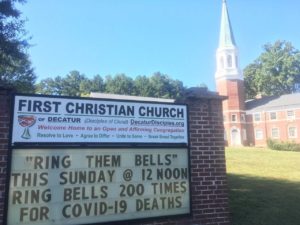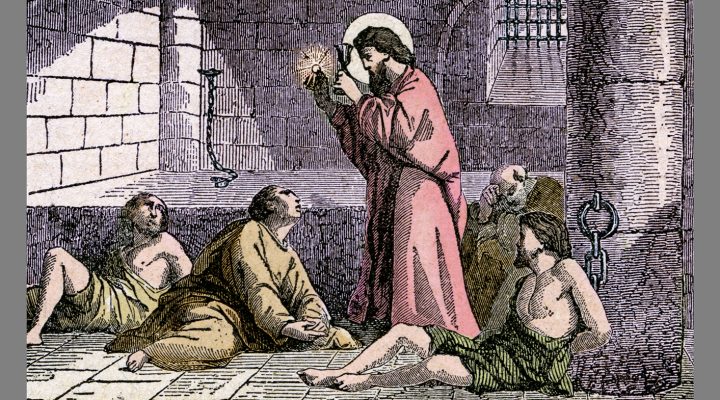This year, thanks to a mischievous convergence of the cultural and liturgical calendars, Ash Wednesday falls on Valentine’s Day. It’s not the first time (2018 wasn’t that long ago) nor will it be the last (next up is 2029).
Theologically, intertwining the start of Lent with a focus on love really ought to be an annual occurrence. We do not enter Lent hopeless or spurned. Properly understood, Lent is more sober than somber.
Thankfully, blessedly, miraculously we know where the road ends. The journey and the intentionality of Lent are about where and what the road must go through. The main challenges of this cultural and liturgical convergence are emotional and logistical: How does one navigate romantic dining and spiritual fasting, the giving of flowers and the receiving of ashes?
The love angle will (rightfully) be front and center in many Ash Wednesday homilies. But for this first post-pandemic Ash Wednesday/Valentine’s Day mashup, I want to suggest a different angle — not a substitute, but a supplement.
Patron saint of plagues

Artist’s representation of St. Valentine
We all know St. Valentine is the patron saint of love. Not so well known is his role as the patron saint of plagues. How Valentine came to be associated with an affliction of the body as well as the heart is shrouded in the mists of history.
Tales from 12th-century Normandy attribute many miraculous healings to a relic skull, said to be the head of St. Valentine, housed in the monastery at Jumieges. Pilgrims cured from plague feature in these accounts. Later stories also credit the relic with saving the parish population from an epidemic in 1693. Research by literary scholar Jack Oruch shows healings such as these were associated with St. Valentine long before his feast day was a focus for romance.
As we enter a solemn period of penitence and contemplation, Feb. 14, 2024, thus provides a fruitful opportunity for us to reflect upon both the American church’s resilience and its need for repentance related to the plague that was the COVID-19 pandemic. These reflections can guide us to be a more faithful people in the weeks, months and years ahead — and that is reason for the season of Lent.
Pandemic evaluation
By certain measures, churches have weathered the pandemic quite well. Some congregations have even experienced growth and vitality. As Jeff Brumley reported last autumn, a Hartford Institute for Religion study reveals that, across denominations, median attendance, offerings and volunteer rates all have rebounded significantly from the deficits COVID exacted on congregational life. Most (80%) church leaders surveyed felt optimistic about the future of their faith community and the American church in general.
Other studies convey similar positive trends. Pew Research Center found 30% of U.S. adults say the pandemic strengthened their faith. A November 2023 Lifeway tracking poll of U.S. Protestant pastors indicates worship attendance at many churches is returning close to pre-pandemic levels.
However, all such studies should be approached with tempered optimism because all such surveys only reflect the experience and perspectives of churches who survived COVID. They do not reflect the sizeable number of local church closures that occurred during and shortly after the pandemic. Neither do they factor in the sizeable numbers of clergy and laypeople who left the church during or shortly after the pandemic.
That the crucible of lockdowns and other pandemic trials brought a sizeable percentage of Christians closer to God should be noted and celebrated; but this realization does not change (nor should it be allowed to obscure) the larger trend that far fewer Americans now self-identify as Christian or claim any religious tradition.
“The metrics used in all these surveys are inward facing in their focus and rather secular in their calibration.”
Most telling, the metrics used in all these surveys are inward facing in their focus and rather secular in their calibration. They measure churches as local organizations rather than as outposts of heaven called to be living expressions and extensions of the body of Christ. They say nothing about what churches are doing or how faithfully they are doing it, only that people are showing up for it, giving their time to it and donating their money toward it.
No doubt, congregants do all three of these things genuinely because they find value in the rhythms and activities of their church’s life and are motivated by some sense of responsibility to support them. But the same easily can be said of any active sports, hobby or civic club. How the American church did in living out its calling to love God and love neighbour during the pandemic doesn’t register in these surveys, and assessing what churches’ neighbors think has not, to my knowledge, been attempted.

A church in Decatur, Ga., invites the community to commemorate those who have died from COVID-19. (Photo/James Brewer-Calvert)
Churches did not make a whole lot of news during COVID if for no other reason than pastors and lay leaders were, understandably, swamped with concerns internal to their congregations. Many if not most churches experienced high levels of anxiety, driven by Trumpian political tension, conspiracy theories, the administrative demands of navigating changing social distancing requirements, and the mental and emotional strain of having to learn to do church virtually. Congregational leaders weren’t making waves; they were trying to avoid being pulled out to sea.
Those churches that did make headlines tended to do so for less than Christ-like reasons: defying mask mandates out of a distorted view of “freedom” or being identified as “superspreaders.” The most vocal churches seemed far more interested in their First Amendment “right to worship” than anything to do with the second part of the Greatest Commandment. By these measures, COVID-19 was not the American church’s finest moment. Now that the pandemic is well behind us, the time is ripe for earnest and honest reflection — not just in the American church but around the world.
Pastoral care for crisis
In the United Kingdom, Roger Abbott of The Faraday Institute for Science and Religion has called on churches to reclaim a theology (and an ecclesiology) of pastoral care for the common good in preparation for the next social crisis. In a paper titled “Pastoral Care for the Common Good: How the Church Can Respond Better in the Next Pandemic,” Abbott says the first step toward more faithful witness in times of trouble is recognizing our guilt in all-too-often adopting the “narcissistic individualism” of Cain (See Genesis 4:9).

Roger Abbott
“Am I my brother’s keeper?” Yes. If we walk and stand with God, yes is the only acceptable answer to that rhetorical question. The Golden Rule, the Parable of the Good Samaritan, the Parable of the Sheep and the Goats — these are but a few of the foundational Scriptures that direct our focus outward toward one another. All Christians, and all congregations, have a God-given mandate to love and care for those outside as well as inside the church walls in good times and, especially, in challenging times.
Abbott argues if loving neighbor were more central to the church’s missional and ecclesial focus, congregations’ response to the pandemic would have looked very different. And Abbott contends much of the internal tension and in-fighting that erupted over pandemic regulations would not have boiled over because more important things would have held congregants’ attention and energy.
Abbott does not preclude churches protesting or defying pandemic mandates or other civic regulations. There are times and situations in which protesting, even disregarding, laws is necessary and appropriate if we are to “obey God rather than human authority” as taught in Acts 5:29.
“It is not so much that churches challenged pandemic restrictions but why that leaves much to be desired.”
It is not so much that churches challenged pandemic restrictions but why that leaves much to be desired. Contravening social distancing regulations to ensure those on the margins continue to receive essential services is very different from violating a mask mandate so choir practice can continue as normal.
Lesson from a plague preacher
To help us reflect on the church’s response during COVID and begin preparing for future social emergencies, Abbott recommends revisiting the sermons of the 16th-century Zurich pastor Ludwig Lavater, which he believes stand as a model for how churches can “understand and respond” to extraordinary circumstances.
Living in a time of plague and famine, Lavater helped his congregation grapple theologically with widespread suffering while exhorting them to respond faithfully, with special emphasis on our scriptural imperative to visit and care for the sick. In reading these sermons you may, as I do, disagree with more than a few of Lavater’s theological positions and conclusions; however, the balance he strikes between wrestling with God and acting as an instrument of Christ’s love reflects what life lived fully in Jesus should look like. As Abbott rightly points out, in the 500 years that have lapsed since Lavater preached, “neither the concept of deeply compassionate pastoral care nor its principles of practice have changed. Both are steeped in mercy and in the true nature of compassion as practicing help, not just feeling moved.”
Abbott urges the recovery of discipleship as student-ship, as training, as practice for bearing witness to God’s love, mercy and life in Christ. The church’s pandemic witness was stunted because we were caught off guard. We weren’t spiritually ready.
“Spiritual readiness has nothing to do with proficiency in Zoom.”
Spiritual readiness has nothing to do with proficiency in Zoom. It has everything to do with posture, with having a clear sense of mission and calling to be an outpost of heaven on earth beyond the logistics of running programs and holding meetings. No person, no organization, no church can prepare for a crisis in the midst of that crisis. Preparation must happen ahead of time.
The church’s most faithful witness always occurs when we stand with God by standing for those who are suffering, struggling and scorned — from the streets of Rome where third-century Christians risked their lives to tend to the sick and the dying during the Cyprian Plague, to the 16th-century Zurich parish where Lavater preached and his congregation ministered during widespread calamity, to the streets of Selma where 20th-century Christians risked their lives marching peacefully in the face of violent resistance to human dignity and equality.
Walking in love, mercy, justice and the peace that surpasses all understanding among neighbor and stranger, with friend and foe, that is how we embody and ultimately proclaim news that is good and grace that is amazing. When we seek our own safety and self-interest, or trumpet the surety of our own sanctity, we do little more than sound grating gongs and clang cringeworthy cymbals, no matter how frequently or confidently we speak the name of Jesus.
Practicing help, not just feeling moved. That’s a good goal for making our way through Lent and preparing ourselves for whatever the future holds. Because that’s what loving our neighbors as ourselves entails — in the best of times, in the worst of times.
Todd Thomason is a gospel minister and justice advocate who has served as pastor of churches in Virginia, Maryland and Canada. He holds a doctor of ministry degree from Candler School of Theology at Emory University and a master of divinity degree from McAfee School of Theology at Mercer University. Currently, he is a Ph.D. candidate in New Testament and Christian origins at the University of Edinburgh in Scotland. In addition to Baptist News Global, Todd writes at viaexmachina.com.


